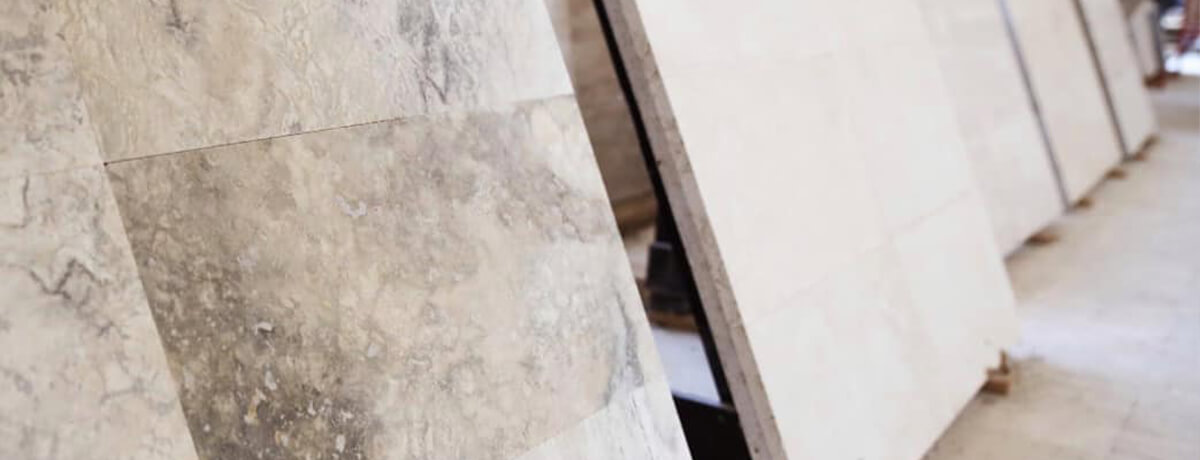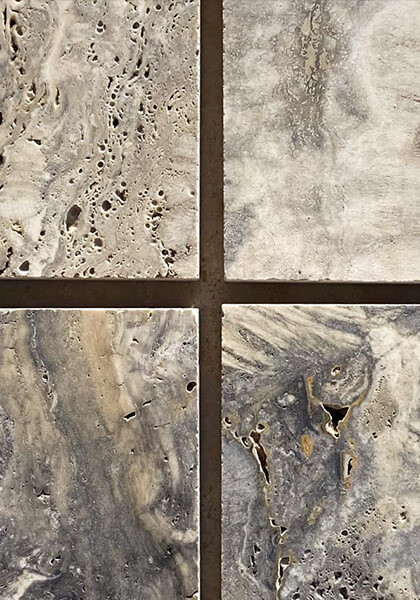Trending Travertine Tiles
13th Jul 2022

Are you considering a home makeover? Do you want to create an exquisite atmosphere with a timeless, durable, and natural material that will take the breath away of every guest?
Have you heard of travertine tiles? Travertine is a natural stone loved by emperors in ancient Rome and modern architects. It is one of the most exquisite, elegant exterior and interior trend of 2022. Today, designers and architects love to use travertine for indoor and outdoor flooring, wall cladding, pool decks, bathroom decor, and so much more.
Travertine is among the most popular options for any home interior, regardless if you are going for a more rustic or contemporary look. But what makes travertine tiles so versatile and timeless? In this article, we will look at the types of travertine tiles and their finish. We will point out their undeniable advantages and share expert opinion on the most popular travertine tile’s shape and sizes.
Are you ready for a fresh home makeover for 2022 and a gorgeous travertine flooring that will give your home a mesmerizing new look with a luxurious appeal?
What gives Travertine tiles their structure and their unique appearance?
Those interested in stone, who have heard of travertine, probably know some of the special characteristics of this beautiful natural stone. Travertine is a sedimentary stone, formed by mineral springs, hot springs in particular, through the rapid precipitation of calcium carbonate as the water cools. Then, under strong pressure for many thousands of years it strengthens into travertine trapping within it the topographic and natural elements which make travertine so characteristic.
Travertine is famous for its porosity. That is its most unique feature, together with its veining. The porous texture is formed by bubbles of sulfur dioxide, which rise up through the limestone mixture and by the natural layering of this sedimentary stone in an open landscape context (as opposed to Marble forming at the bottom of the sea).
If the travertine gets cut in a direction parallel to the formations by precipitation, the holes tend to be round. And if the stone is cut perpendicular to the formations, then the holes in it will be more elongated to the side where the layers of the limestone are formed.
Water did not always come to the surface in the same way, the currents changed with time, and, as a result travertine formed during different periods. Sometimes the process of formation stops and then resumes. For this reason, travertine contains colour variation which is very specific to the place where it is formed. Therefore, this could possibly explain the reason for the appearance of the unique gray in travertine at Saturnia, which shows natural elements of river origin specific to the area.
Trending Travertine Tiles Finish, Shape and Sizes
Travertine is most commonly used for flooring and wall cladding. It comes in diverse colors and shades. Keep in mind that no two tiles are the same because their beautiful patterns are formed naturally over thousands of years.
Tiles may come in several different finishes:
Brushed
This finish has a non-reflective matte look due to treatment with a wire brush which give the stone a slight orange peel effect. It is non-slip and wonderful to touch with bare feet or hands.
Polished
That's the shiny, glossy finish of travertine. It is gorgeous, eye-catching, and very evocative. This finish really brings out the natural colours of the stone but it is the least slip resistant and is used in specific areas.
Tumbled
This finish is more suitable for rustic decor. It is treated in such a way to make the tiles look aged, rough, and more weather-worn, reminiscing ancient times. Tumbled is usually only used with unfilled travertine.
Honed
The honed finish is halfway between gloss and matte, giving that slightly polished yet not shiny appeal, allowing the travertine's natural beauty to pop out. It is our most popular finish balancing all aesthetic and practical aspects.
Filled or Unfilled
Travertine tiles can come filled or unfilled depending on clients’ specific requirements and preferences. Filled tiles are the smooth option, without pores, filled with a specific colour matched cement. Unfilled tiles have their natural porous structure.
Shape and Sizes
So speaking of trending travertine tile finishes, you are probably wondering what type of travertine tile are popular now in terms of shapes and sizes. After all, travertine is an ageless building material which never goes out of fashion but the popularity of certain formats does change over time.
Today, our experts say that square travertine tiles are more popular than rectangular ones. Square tiles that are equal in size can be aligned at 45 degrees to any surface, including halls and outer walls. That can easily create a diagonal pattern and give the illusion of more space.
Whereas small format tiles were popular some time ago, larger tiles (40x40cm, 50x50cm, and 60x60cm) are more popular nowadays, and with good reason. These bigger formats allow to show more of the natural stones veining and colour patterns which make travertine so beautiful. However, it is harder to install natural stone tiles or stone pieces bigger than that due to the weight and special requirements like the need for a perfectly flat supporting base (travertine is not flexible), more workforce, as well as specific tools, glues, etc.
Benefits and Advantages of Travertine tiles
Undoubtedly beauty and style are the first advantages of travertine tiles. The classical beauty of travertine flooring is unparalleled. Imagine the soft, mesmerizing patterns and nuances created by nature. Simply breathtaking.
Travertine tiles are extremely durable. With the proper maintenance and treatment, you can have fresh-looking tiles - free of scratches and cracks with the perfect finish for a lifetime to come.
Another benefit to having natural stone as decor and especially travertine is value. If you are planning to sell your property, installing travertine as flooring, wall cladding, or simply using it as a decorative element in your house will significantly increase your estate's value.
Travertine is Timeless
When we talk about trends with travertine, we have to mention its timelessness. This stone is timeless in terms of durability, and it will always be a popular choice for those who love luxury in decor. The beauty of travertine remains as the stone changes with time. Because it is a natural material, even in formation when in contact with air, this stone hardens as calcium bicarbonate continues to be converted to calcium carbonate. After extracting travertine, its color begins to change. If it was previously paler, due to the oxidation of iron found in the stone, it could acquire a more beige, yellowish creamy shade.
Another interesting fact is that its strength improves over time. When interacting with air, its surface becomes denser and denser. Sedimentary stones can harden over time. That explains why the ancient buildings of this material have not yet collapsed. This stone is resistant to temperature changes. For this reason, travertine is often used in exterior wall cladding.
In Conclusion...
The stone is famous for its wide range of textural styles. Its color palette ranges from creamy white to dark beige and even silver. The stone is extremely durable, and it can withstand harsh weather conditions just as easy as a heavy load of everyday traffic. Travertine is a timeless and always trendy decor material for any home or office building and the large square tiles bring out the best of the stone, the project and will be sure to woo all your guests.

